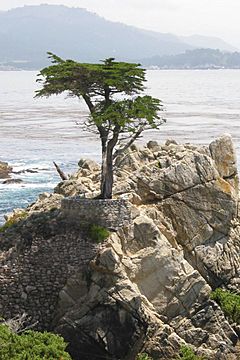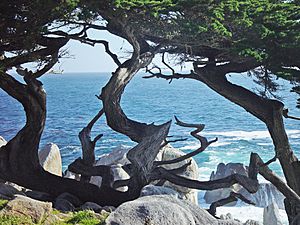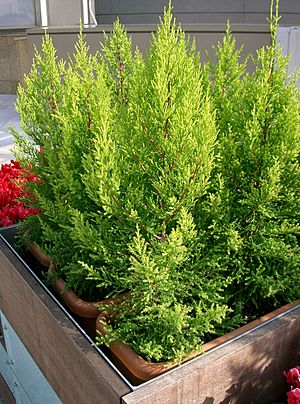Monterey cypress facts for kids
Quick facts for kids Cupressus macrocarpa |
|
|---|---|
 |
|
| The "Lone Cypress" near Monterey, California | |
| Scientific classification | |
| Kingdom: | |
| Division: | |
| Class: | |
| Order: | |
| Family: | |
| Genus: | |
| Species: |
C. macrocarpa
|
| Binomial name | |
| Cupressus macrocarpa Hartw. ex Gordon
|
|
The Monterey cypress, also known as Cupressus macrocarpa, is a special type of cypress tree. It naturally grows in only two small places along the Central Coast of California. These areas are near Pebble Beach and Carmel. This tree is famous for its unique shapes, often sculpted by the strong winds from the ocean.
Contents
Description
What Does the Monterey Cypress Look Like?
The Monterey cypress is a medium-sized evergreen tree. This means it stays green all year round. It often grows into an uneven, flat-topped shape. This happens because of the strong winds in its natural home.
In good conditions, these trees can grow very tall, up to 40 meters (about 133 feet). Their trunks can also become quite wide, reaching over 2.5 meters (more than 8 feet) across.
Leaves and Cones
The leaves of the Monterey cypress grow in thick bunches. They are bright green and smell like lemon when you crush them. The leaves are small and scale-like, about 2–5 millimeters long. Young trees, less than a year old, have needle-like leaves that are a bit longer.
The tree produces seed cones. These cones are round or oval-shaped, about 20–40 millimeters long. They have 6 to 14 scales. When they first appear, they are green, but they turn brown as they get older. This takes about 20 to 24 months after the tree is pollinated. The pollen cones are smaller, about 3–5 millimeters long. They release their pollen in late winter or early spring.
How Old Can They Get?
For a long time, people thought some Monterey cypress trees could live for up to 2,000 years. However, scientists have studied this more closely. The oldest tree found so far, based on real evidence, was 284 years old.
Distribution
Where Do Monterey Cypress Trees Grow?
The two main groups of native Monterey cypress trees are protected. They are found in Point Lobos State Reserve and Del Monte Forest. The natural home of these trees has cool, damp summers. It is almost always covered in sea fog.
Even though it only grows naturally in two small spots, the Monterey cypress has been planted in many other places. You can find it along the coasts of California and Oregon. It has even been grown in Kenya to see if it can be used for timber.
Cultivation
How People Use and Grow Monterey Cypress
People have planted Monterey cypress trees far from their original home. They grow well in other areas with similar cool summers and mild winters. It is a popular tree for gardens and public parks in California.
The leaves of the Monterey cypress can be a little bit harmful to livestock, like cows. It can cause problems for them if they eat too much.
The wood from these trees is used by many craftspeople. Some boat builders and small businesses use it. It is good for making furniture and other decorative items because of its nice colors. The wood also burns quickly and hot, but it can spark a lot. So, it's not the best for open fires.
In Australia and New Zealand, Monterey cypress trees are often planted in rows. These rows act as windbreaks on farms. They help protect crops and animals from strong winds. They are also planted as pretty trees in New Zealand, and sometimes for their wood.
See also
 In Spanish: Cedro de Monterrey para niños
In Spanish: Cedro de Monterrey para niños



